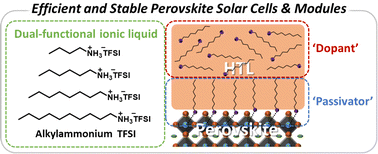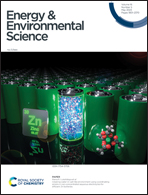Alkylammonium bis(trifluoromethylsulfonyl)imide as a dopant in the hole-transporting layer for efficient and stable perovskite solar cells†
Abstract
In state-of-the-art n–i–p structured perovskite solar cells (PSCs), a dopant for doping hole transporting materials (HTMs) is a crucial component, which affects not only the electrical properties of HTMs, but also the performances and stabilities of PSCs. In this paper, we report new dual functional ionic liquids (ILs) consisting of various alkylammoniums (from butyl to decyl) and bis(trifluoromethylsulfonyl)imide (denoted as BATFSI, HATFSI, OATFSI, and DATFSI) as a dopant and surface passivator for highly efficient and stable PSCs and modules. Among these ILs, OATFSI provides enough miscibility with a poly(triarylamine) solution, which results in a smoother morphology of the hole transporting layer (HTL) with an enhanced electrical property via efficient doping. Simultaneously, OATFSI passivates the perovskite surface in situ, during spin-coating deposition of the HTL. Highly efficient and stable OATFSI-based PSCs are fabricated with a mesoporous n–i–p structure and a maximum power conversion efficiency (PCE) of 23.34%, due to reduced non-radiative recombination and better charge extraction. To verify the scalability of our new IL dopants, perovskite modules with a high PCE of 18.54% (on the aperture area of 224.89 cm2) and 19.91% (on the active area of 209.39 cm2) are demonstrated. We believe our work provides useful guidelines to achieve efficient and stable PSCs and modules for commercialization.



 Please wait while we load your content...
Please wait while we load your content...